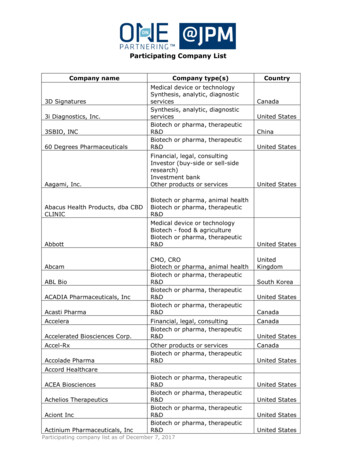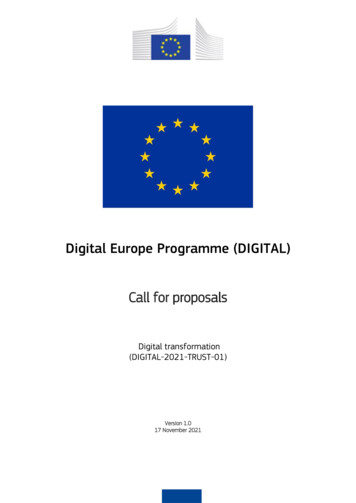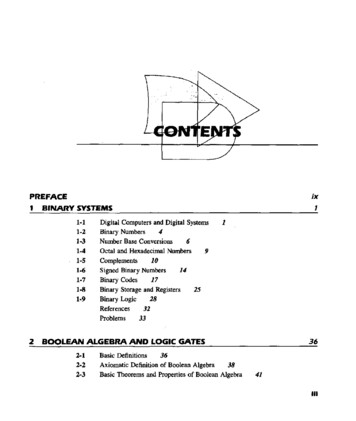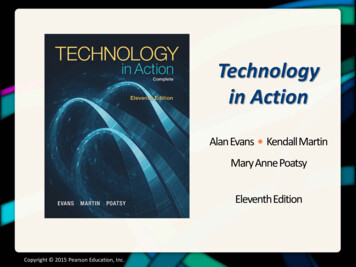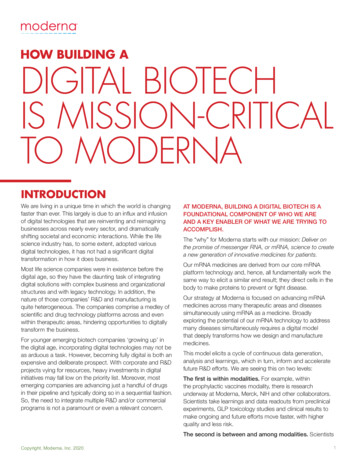
Transcription
HOW BUILDING ADIGITAL BIOTECHIS MISSION-CRITICALTO MODERNAINTRODUCTIONWe are living in a unique time in which the world is changingfaster than ever. This largely is due to an influx and infusionof digital technologies that are reinventing and reimaginingbusinesses across nearly every sector, and dramaticallyshifting societal and economic interactions. While the lifescience industry has, to some extent, adopted variousdigital technologies, it has not had a significant digitaltransformation in how it does business.Most life science companies were in existence before thedigital age, so they have the daunting task of integratingdigital solutions with complex business and organizationalstructures and with legacy technology. In addition, thenature of those companies’ R&D and manufacturing isquite heterogeneous. The companies comprise a medley ofscientific and drug technology platforms across and evenwithin therapeutic areas, hindering opportunities to digitallytransform the business.For younger emerging biotech companies ‘growing up’ inthe digital age, incorporating digital technologies may not beas arduous a task. However, becoming fully digital is both anexpensive and deliberate prospect. With corporate and R&Dprojects vying for resources, heavy investments in digitalinitiatives may fall low on the priority list. Moreover, mostemerging companies are advancing just a handful of drugsin their pipeline and typically doing so in a sequential fashion.So, the need to integrate multiple R&D and/or commercialprograms is not a paramount or even a relevant concern.AT MODERNA, BUILDING A DIGITAL BIOTECH IS AFOUNDATIONAL COMPONENT OF WHO WE AREAND A KEY ENABLER OF WHAT WE ARE TRYING TOACCOMPLISH.The “why” for Moderna starts with our mission: Deliver onthe promise of messenger RNA, or mRNA, science to createa new generation of innovative medicines for patients.Our mRNA medicines are derived from our core mRNAplatform technology and, hence, all fundamentally work thesame way to elicit a similar end result; they direct cells in thebody to make proteins to prevent or fight disease.Our strategy at Moderna is focused on advancing mRNAmedicines across many therapeutic areas and diseasessimultaneously using mRNA as a medicine. Broadlyexploring the potential of our mRNA technology to addressmany diseases simultaneously requires a digital modelthat deeply transforms how we design and manufacturemedicines.This model elicits a cycle of continuous data generation,analysis and learnings, which in turn, inform and acceleratefuture R&D efforts. We are seeing this on two levels:The first is within modalities. For example, withinthe prophylactic vaccines modality, there is researchunderway at Moderna, Merck, NIH and other collaborators.Scientists take learnings and data readouts from preclinicalexperiments, GLP toxicology studies and clinical results tomake ongoing and future efforts move faster, with higherquality and less risk.The second is between and among modalities. ScientistsCopyright, Moderna, Inc. 20201
across the ecosystem have access to real-time data andinformation; learnings in one therapeutic area often arereapplied to another therapeutic area.We rely on digitization to ensure seamless integration acrossthe ecosystem, the ability to share and access data and thecapability to scale and satisfy an ever-increasing demand forresearch mRNA for preclinical and GLP toxicology studies,as well as GMP mRNA to supply an expanding number ofclinical studies.Enabling a 20-year innovation cycleWe believe we are at the beginning of a 20-year mRNAinnovation cycle that most technologies go through beforetheir performance has been optimized. We hope to findearly successes and advance ongoing improvements tothe technology that will permit an ever-greater number ofopportunities as we invest in the platform.Achieving success involves several factors, including learningthe fastest and scaling rapidly, all while maintaining thehighest quality. The only way to ensure this will happen isthrough digitization. Since Moderna’s inception, we haveinvested over 100 million on our digital technologies,robotics/automation, analytics, data science and AI.Given our growth, we expect we will invest more than 100million in digital over the next 5 years.Benefits of DigitizationQUALITY: Reducehuman errors by enablingautomation, repeatabilityand seamless integrationwherever possible.SPEED: Provide largequantities of mRNA acrossthe ecosystem in a rapidtimeframe to permit theacceleration of rationalmRNA drug design and togather, analyze and sharedata in real time to informdecision making.Digitization Building Blocks1) Cloud enablement is a must-have component of ourdigital infrastructure. Our science is rich in complex datasets, and our scientists need computational power, agility tooperate, cost effectiveness and efficiencies in organizing andprocessing data without being hindered by the limitations oftraditional computing technology.2) Integration includes looking for every opportunityto bring our processes and data together in a consistentmanner, avoiding ‘silos of information’ and manualintervention. This flow of data between systems,internally and/or externally, enables the automation of ourbusiness processes and the real-time synchronizationof our operations. Many companies struggle due tolegacy systems, siloed data and processes and inherentinefficiencies. To that end, as we grow, we have beenorganizing and managing our data around systems ofrecords. These data are then shared and synchronized,enabling real-time data correlations and other learnings.3) Internet of Things is based on smart, interconnecteddevices producing information about their environmentsand operations. This immense new source of data frominstruments and environments provides real-time guidanceCopyright, Moderna, Inc. 2020SCALABILITY:Accommodate an everincreasing number ofmRNA R&D programswithin and acrossmodalities.COST: Create aninfrastructure that can beleveraged across all R&Dprograms to maximizeefficiencies.to our scientist and engineers and helps us in supplychain and manufacturing with compliance and traceability,including tracking material, controlling inventory andoptimizing instrument usage.4) Automation is radically transforming businesses anddriving a new technology-driven revolution worldwide. Withthe help of robotics, we reach an unprecedented levelof automation that increases our operations’ accuracy,repeatability and throughput, and reduces human errors,dramatically improving our quality and compliance.5) Analytics are necessary to harness the power of ourdata. Using the latest tools and analytical methods, wehave designed an environment that enables us to undertakeany kind of analysis. Having rich and complex data readilyavailable enhances our capability to generate scientific andbusiness insights to make informed decisions.6) Artificial Intelligence (AI) is enabling keybreakthroughs in analytics and predictive modeling thathelps accelerate our learning cycle drastically, providing uswith critical insights into research and production data thatwere otherwise inaccessible and unachievable.2
OUR DIGITIZATION STRATEGYOUR BUSINESS STRATEGY is to advance a broad arrayof mRNA medicines for many diseases simultaneouslyto deliver on the promise of mRNA science for patientsas quickly as possible. Central to this strategy is theenablement of parallel progress and shared learning, byvirtue of a digital infrastructure, built from the groundup, that exploits the inherent replicability of mRNA and itssoftware-like features. As a result, scientists at Moderna andour collaborators are progressing dozens of mRNA R&Dprograms concurrently.Our digital team works closely with their businesscounterparts, defining a digital way of operating that reducesunnecessary process complexity, uses AI to augment ouranalytics, and incorporating automation. We designedsystems from the ground up to use cloud services and tointegrate seamlessly. We organize and manage our dataaround systems of records with related data sets, that arethen shared and synchronized to enable real-time utilization.needs of our technical and scientific efforts – our ResearchEngine and our Early Development Engine.Our Research Engine is designed to move many mRNAresearch programs simultaneously from concept todevelopment candidate nomination. Our Early DevelopmentEngine then advances development candidates throughclinical studies to human proof-of-concept. Each has uniquerequirements as well as the need for continuity between thetwo engines, we utilize both internally developed softwareand algorithms and standard off-the-shelf solutions. Internalsoftware and algorithms support the high need for specificityand differentiation in research as well as the frequentchanges that require short delivery cycles. Off-the-shelfsolutions, including innovative emerging technologies, arethen integrated to ensure seamless business processes.We have two core “engines”, highly adapted to the uniqueRESEARCH ENGINE DIGITIZATIONOUR SCIENTIFIC DIGITAL ENVIRONMENT prioritizes two goals, the rational design ofmRNA medicines and the acceleration of programs through research.Research ning and Ordering mRNAOur scientists turn ideas into mRNA designs using a suiteof tools called the Drug Design Studio (DDS). DDS containsa sequence design app that allows scientists to build novelmRNA sequences using a library of existing sequencecomponents or ones they import. Embedded AI algorithmsconvert amino acid sequences into nucleotide sequencesand optimize a sequence for production.Our existing algorithms use heuristics learned from yearsof accumulated knowledge around the interactions ofmRNA sequence with both production yields and proteinCopyright, Moderna, Inc. 2020expression. Our next generation mRNA and protein designalgorithms use neural networks to incorporate largepublic datasets with our proprietary data to find emergentrelationships to improve our mRNA performance.Once designed, mRNA is sent to our Preclinical Productionteam using the DDS Ordering app, which configures theideal properties for both mRNA and formulations. DDSOrdering automatically performs several AI sequence qualitychecks and optimizations before sending the order toPreclinical Production.3
Producing Preclinical mRNAmRNA production is triggered in our Preclinical Productionapp. The app coordinates every step of the productionprocess, from the initial creation of the DNA plasmidtemplate to the final formulated mRNA. Full automation hastaken the place of manual work when it comes to liquidhandling, production and quality controls.The tight integration of the instruments with the PreclinicalProduction app and our external vendors allows us tocapture and interpret data at every step of the process, withfull digital traceability for each mRNA construct.Our real-time algorithms and analytics tools embeddedin the app also drive our quality control process and ourcontinuous improvement process. As an example, a logisticregression machine learning algorithm trained on historicaldata predicts which mRNA orders are at risk of producinginsufficient material and restart them early to save time.A rules-based algorithm also optimizes partial containerselection when choosing raw materials for efficiency.One of our more advanced AI implementations in PreclinicalProduction is for automated Sanger sequencing analysis.Sanger sequencing is used repeatedly to QC our DNAtemplates and final mRNA; while the data contain everynucleotide in a sequence, it is very complex to analyze. Afully automated data pipeline starts processing raw datathe moment it is saved to the cloud by the sequencers.The pipeline spawns numerous AWS computer servers torun an analysis algorithm and then shuts the servers down,resulting in minimal costs. The results are viewable in apowerful, dynamic visualization tool. To date, we’ve run over3 million Sanger data files through this system.Using vast amounts of internal data, we have furtherimproved our Sanger analysis with a convolutional neuralnetwork (CNN) to better analyze the tail sections of mRNA.These long polyA stretches convolute the Sanger data andmake analysis difficult. We trained a CNN on over 20,000labeled data files generated from expert operators, whichnow immediately returns a pass/fail score that exceedsindividual human performance. This algorithm increases theconsistency and quality of our mRNA and saves countlesshours of manual human analysis.We’ve also leveraged our data to rebuild the Sanger analysisalgorithm from the ground up. The original analysis wasbased on an off-the-shelf algorithm, with some modificationsby Moderna. While this algorithm has been a standardtool in the industry for 20 years, we found it was oftenmissing subtle failure modes, such as when only a subsetof samples has a mutation. This results in lower quality andmore manual reviews. Our solution was to start from a blankpage and build an entirely new algorithm from the ground upusing a variety of Bayesian inference techniques. The newModerna-created algorithm shows consistent accuracy forpure samples but also catches these other more challengingCopyright, Moderna, Inc. 2020failure modes that the old one missed. The new algorithm isalso intuitive and extensible but requires 100x the computingpower. However, with our modern cloud infrastructure wecan access this computational power easily.The extensive robotic automation and AI in our preclinicalscale mRNA production contributes dramatically to reducingour cycle time, increasing our throughput, and helping usdeliver consistent, high quality mRNA at the lowest possiblecost.Dispatching and Shipping mRNAOur Shipping app automates dispatching and shipping ofmRNA for internal use and to external partners globally. Theapp is also used to coordinate biological sample shipmentsfrom in vivo/vitro studies to teams who prepare and analyzethem. The app produces the appropriate labels and customsforms and drives the shipment and receiving with a click of abutton or tap on a smartphone. The app also generates realtime notifications on shipment status to all parties.Inventory and RegistryEvery material used and created in research and inpreclinical production is tracked in the Inventory app.This includes mRNA, animal tissues, cell lines, chemicals,reagents, and much more. The app has numerous workflowtools like consumption, aliquoting, material transfer andstock alerts.Critical material types are also assigned unique registry IDsby our Registry app, for every type of unique material withwhich Moderna’s systems interact. Unique IDs, used allthrough the research and development of an mRNA andits components, allow systems and processes (includingoffline processes) to ensure they are all referring to the samematerial.Study DesignTo design in vivo and in vitro studies, our scientists use ourIn Vivo and In Vitro Study apps. Once a study is registered,the Study apps helps scientists plan their study, order mRNAconstructs and track progress.The integration of the Study apps with our production andin vivo planning tools provides scientists with immediatevisibility to the availability of the resources they require fortheir experiment, real-time progress report and improvementsuggestions. The goal is to optimize overall study outcomes,resources and cycle time.The Study apps capture varied and complex in vivo and invitro study protocol designs—including all necessary doses,samples, assays, etc. – and generate a precise plan forstudy activities that the operations team executes.4
Experiment Managementsimplicity, usability, workflow capabilities, e-signature andreporting. We are also working to integrate it further toconnect Inventory, Studies, and instrument data directly withthe notebook. Our scientists’ data management has become‘smarter,’ with information they can trust, accelerating theirability to make decisions, share and collaborate.We have deployed electronic lab notebooks to streamlineand track experiments in a standardized, searchablerepository. We chose IDBS’ new web-based E-Workbookelectronic lab notebook because of its modern design,EARLY DEVELOPMENT ENGINE DIGITIZATIONOUR EARLY DEVELOPMENT PROCESS starts when we nominate a development candidate(DC) that we intend to progress to IND and clinical trials. This process from start to finish,without exception, has been digitized. Our DC approval workflow from candidate selection toDC nomination allows us to review the data and electronically approve the DC. Once approved,the DC’s attributes and data are tightly controlled. From this point forward digitization focuses ondriving the clinical and operations process, solving for quality, safety, time and cost, making surethe DC remains on track to reach the next development milestone.Clinical Development and Operations Process (C&OP)DCNomination?GLP/ToxMfg DSIn VivoTox StudyGMPMfg ActivationDrugResuppliesCommercialTechnical development requires a broad spectrum of digitalcapabilities including electronic notebooks, structured datacapture, integrated equipment and high throughput testing.Our strategy incorporates data integrity and knowledgemanagement with speed of execution and time-to-insight,using a blend of off-the-shelf and custom software.Process DevelopmentNovel experimentation and characterization work is capturedin our electronic lab notebook and tagged with attributes toorganize our process learnings. Process experimentationis modeled in our proprietary platform editing software andallows us to create structured experiments, which are thenexecuted in our custom Development Hub software whichinterlinks all sample testing requests, inventory managementand key process equipment to support analytics for rapidinsights.Early stage analytical development is performed using offthe-shelf analytical software and the data and outcomes areCopyright, Moderna, Inc. 2020ClinicalModelingPhases 1-3RegistrationTechnical DevelopmentAnalytical DevelopmentClinicalMonitoringstored in our electronic lab notebook. Whenever possible weleverage the same systems between Analytical Developmentand Quality Control to accelerate the transfer of testingmethods to production. This includes a shared, cloud basedHPLC management system and integrated laboratoryexecution system. High throughput testing to support rapiddecision making on process experiments is performed usingintegrated robotics and high-throughput test methods.Pilot Operations and Technology TransferPilot operations produces material for toxicology studiesand when possible leverages the same equipment andprocesses to help ease the transfer into GMP operations.Execution is being implemented in our Development Hubsoftware and equipment is integrated with our processhistorian which allows us to compare data sets withGMP operations. Data to support technology transfer isgenerated in structured reports and our platform editorsoftware can be used to automate transfer reports andgenerate an electronic batch record design.5
Clinical DevelopmentAs we began nominating DCs from our preclinical pipeline,efficiently managing the portfolio became a top priority.Our Clinical and Operations Planning (C&OP) processdigitization is designed to help plan resources and track theexecution of each DC from nomination through its variousclinical trial phases, with a suite of apps that provides a360 degree view of all the steps: regulatory filing, GLP Tox/GMP manufacturing, in vivo toxicology studies and clinicalscheduling.IMOThe IMO app enables the program leads in ourInvestigational Medicines Office to plan the development oftheir DCs. Program leads input Clinical Development Plans(CDPs) which detail the timing of studies, cohort sizes, doselevels, etc., which are then integrated with other systems.Data
systems from the ground up to use cloud services and to integrate seamlessly. We organize and manage our data around systems of records with related data sets, that are then shared and synchronized to enable real-time utilization. We have two core “engines”, highly adapted to the unique
